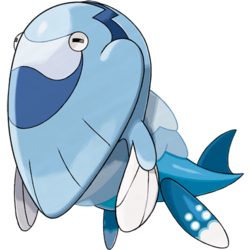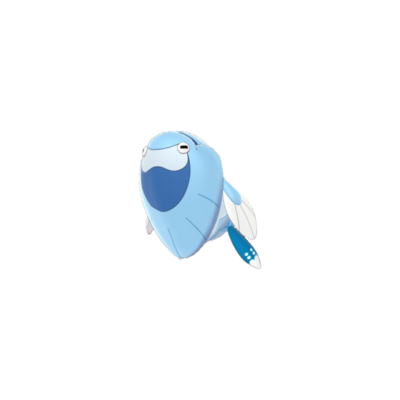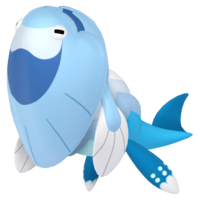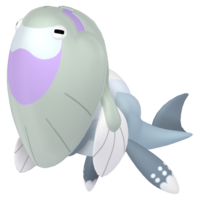From Bulbapedia, the community-driven Pokémon encyclopedia.
Arctovish (Japanese: ウオチルドン Uochilldon) is a dual-type Water/Ice Fossil Pokémon introduced in Generation VIII.
It is revived from combining a Fossilized Fish and a Fossilized Dino. It is not known to evolve into or from any other Pokémon.
Biology
Arctovish is a fish-plesiosaur hybrid fossil Pokémon. The plesiosaur half is colored blue and white. Arctovish has a blue tail with a fin on top. The flippers are colored blue with white patches on the end and with white spots. The fish half is applied upside down. It has a round blue head with black rectangle pupils, and the mouth is located on top of its head. It has white fins connected to its fish head.
It has trouble eating due to its mouth being on top of its head, even though it captures prey by freezing its surroundings. The skin on Arctovish's face is impervious to attacks. It allegedly became extinct despite this due to breathing difficulties, though this is likely not the case due to Arctovish being combined from two separate Pokémon that each had their niches before going extinct.
Game data
Pokédex entries
| This Pokémon was unavailable prior to Generation VIII.
|
| Generation VIII
|
|
Galar
#377
|
|
Sinnoh
#—
|
|
Hisui
#—
|
| This Pokémon has no Pokédex entries in Brilliant Diamond, Shining Pearl, and Legends: Arceus.
|
| Sword
|
Though it's able to capture prey by freezing its surroundings, it has trouble eating the prey afterward because its mouth is on top of its head.
|
| Shield
|
The skin on its face is impervious to attack, but breathing difficulties made this Pokémon go extinct anyway.
|
|
|
|
|
Game locations
| This Pokémon was unavailable prior to Generation VIII.
|
|
|
|
|
Stats
Base stats
| Stat
|
Range
|
| At Lv. 50
|
At Lv. 100
|
90
|
|
150 - 197
|
290 - 384
|
90
|
|
85 - 156
|
166 - 306
|
100
|
|
94 - 167
|
184 - 328
|
80
|
|
76 - 145
|
148 - 284
|
90
|
|
85 - 156
|
166 - 306
|
55
|
|
54 - 117
|
103 - 229
|
Total: 505
|
Other Pokémon with this total
|
- Minimum stats are calculated with 0 EVs, IVs of 0, and (if applicable) a hindering nature.
- Maximum stats are calculated with 252 EVs, IVs of 31, and (if applicable) a helpful nature.
|
Type effectiveness
| Under normal battle conditions in Generation IX, this Pokémon is:
|
|
|
|
|
|
|
|
|
|
|
|
|
Learnset
|
|
|
|
- Bold indicates a move that gets STAB when used by Arctovish
- Italic indicates a move that gets STAB only when used by an Evolution of Arctovish
|
|
|
|
|
- Bold indicates a move that gets STAB when used by Arctovish
- Italic indicates a move that gets STAB only when used by an Evolution of Arctovish
|
|
|
|
|
- Moves marked with an asterisk (*) must be chain bred onto Arctovish in Generation VIII
- Moves marked with a double dagger (‡) can only be bred from a Pokémon who learned the move in an earlier generation.
- Moves marked with a superscript game abbreviation can only be bred onto Arctovish in that game.
- Bold indicates a move that gets STAB when used by Arctovish
- Italic indicates a move that gets STAB only when used by an Evolution of Arctovish
|
|
|
|
|
- Bold indicates a move that gets STAB when used by Arctovish
- Italic indicates a move that gets STAB only when used by an Evolution of Arctovish
|
Side game data
Evolution data
Sprites
| This Pokémon was unavailable prior to Generation VIII.
|
|
|
| This Pokémon is unavailable in Generation IX.
|
|
|
In the anime
Main series
Major appearances
Minor appearances
Arctovish debuted as an image in A Pinch of This, a Pinch of That!.
In the manga
Pokémon Adventures
Arctovish first appeared in PASS39, where one was restored by Cara Liss.
In the TCG
- Main article: Arctovish (TCG)
Trivia
Origin
Arctovish, like Dracozolt, Arctozolt, and Dracovish, may be based on the concept of chimera in paleontology, which refers to fossils reconstructed from multiple different species or genus of animals, resulting in an inaccurate and mistaken understanding of the animals' biology. In the case of Arctovish, its top half appears to be based on the fish Dunkleosteus, though the frontal pair of fins resemble those possessed by lobe-finned fish such as coelacanths rather than the fins of Dunkleosteus. The upper half may also be based on the Ainiktozoon, an arthropod fossil discovered in Scotland which was reconstructed upside-down. Its bottom half appears to be based on a marine reptile, like a plesiosaur, mosasaur, or ichthyosaur. Arctovish and the other Galarian Fossil Pokémon may also be based on the Crystal Palace Dinosaurs, a series of scientifically inaccurate dinosaur sculptures displayed at the Crystal Palace Park.
The Pokédex entries for all the Galarian Fossil Pokémon mention them being the cause of their extinction, which may be a reference to the outdated hypothesis that the dinosaurs were evolutionarily inert, which made them get bigger, stupider, and more sluggish, to the point they could not sustain themselves.
Arctovish being unable to breed could be a reference to cross-bred animals, which are born infertile (unable to produce offspring).
Name origin
Arctovish may be a combination of arctic, fish, and possibly vicious or Ordovician.
Uochilldon may be a combination of 魚 uo (fish), chill, and -don (common suffix in dinosaur names derived from the Ancient Greek word for tooth).
In other languages
| Language
|
Title
|
Meaning
|
 Japanese Japanese
|
ウオチルドン Uochilldon
|
From 魚 uo, chill, and -don
|
 French French
|
Hydragla
|
From hydro- or Hydre and glagla
|
 Spanish Spanish
|
Arctovish
|
Same as English name
|
 German German
|
Pescryodon
|
From pesce, Kryo-, and -don
|
 Italian Italian
|
Arctovish
|
Same as English name
|
 Korean Korean
|
어치르돈 Eochilldon
|
From 어 (魚) eo, chill, and -don
|
 Mandarin Chinese Mandarin Chinese
|
鰓魚海獸 / 鳃鱼海兽 Sāiyúhǎishòu
|
From 鰓 / 鳃 sāi, 魚 / 鱼 yú, and 海獸 / 海兽 hǎishòu
|
 Cantonese Chinese Cantonese Chinese
|
鰓魚海獸 Sōiyùhhóisau
|
From 鰓 sōi, 魚 yùh, and 海獸 hóisau
|
|
|
|
| More languages
|
 Hindi Hindi
|
चिलोफ़िश Chillofish
|
From chill and fish
|
 Thai Thai
|
อุโอจิรุดอน Uochirudon
|
Transcription of Japanese name
|
|
|
|
Related articles
References
External links

|
This Pokémon article is part of Project Pokédex, a Bulbapedia project that aims to write comprehensive articles on each Pokémon species, as well as Pokémon groups and forms.
|
 For other sprites and images, please see Arctovish images on the Bulbagarden Archives.
For other sprites and images, please see Arctovish images on the Bulbagarden Archives.







